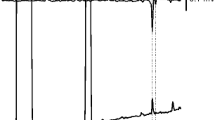Abstract
Reproductive isolation among four sympatric small ermine moths (Yponomeuta) is analyzed in terms of niches in the sexual communication channel. Potential pheromone components were identified from pheromone gland secretions ofY. evonymellus,Y. cagnagellus,Y. padelius, andY. vigintipunctatus by gas chromatography with flame ionization and electroantennographic detection and tested for behavioral activity in the field. The species were found to share (Z)-11-tetradecenyl acetate (Z11-14: OAc) in combination with varying proportions of theE isomer as primary sex pheromone components.Y. cagnagellus differs from the rest of the species by having only a small amount (1.5%) ofE isomer relative toZ isomer in its pheromone. The closely relatedY. padelius has a three-component pheromone including large amounts (ca. 400%) of (Z)-11-hexadecenyl acetate (Z11–16:OAc) in addition toZ11–14: OAc (100%) andE11–14: OAc (34%).Z11–16: OAc appears to reduce trap catches ofY. evonymellus andY. vigintipunctatus when added to the pheromone. Although these species are the two most distantly related European small ermine moths, they seem to share the same sex pheromone, i.e.,Z11–14∶OAc (+20%E) and (Z)-11-tetradecenol. Our interpretation is that this might have been the sex pheromone of the ancestor of today'sYponomeuta species.
Similar content being viewed by others
References
Arn, H., Städler, E., andRauscher, S. 1975. The electroantennographic detector—a selective and sensitive tool in the gas Chromatographic analysis of insect pheromones.Z. Naturforsch. 30C:722–725.
Bjostad, L.B., andRoelofs, W.L. 1983. Sex pheromone biosynthesis inTrichoplusia ni: Key steps involve delta-11 desaturation and chain-shortening.Science 220:1387–1389.
Butler, L.I., andMcDonough, L.M. 1979. Insect sex pheromones: Evaporation rates from natural rubber septa.J. Chem. Ecol. 5:825–837.
Butler, L.I., andMcDonough, L.M. 1981. Insect sex pheromones: Evaporation rates of alcohols and acetates from natural rubber septa.J. Chem. Ecol. 7:627–633.
Gerrits-Heybroek, E.M., Herrebout, W.M., Ulenberg, S.A., andWiebes, J.T. 1978. Host plant preference of five species of small ermine moths.Entomol. Exp. Appl. 24:360–368.
Greenfield, M.D., andKarandinos, M.G. 1979. Resource partitioning of the sex communication channel in clearwing moths (Lepidoptera: Sesiidae) of Wisconsin.Ecol. Monogr. 49:403–426.
Hendrikse, A. 1979. Activity patterns and sex pheromone specificity as isolating mechanisms in eight species ofYponomeuta.Entomol. Exp. Appl. 25:172–180.
Hendrikse, A., Herrebout, W.M., andPersoons, C.J. 1982. Sex pheromones, attractants and inhibitors in small ermine moths: A comparison of bioassays.Med. Fac. Landbouww. Rijksuniv. Gent. 47:493–502.
Herrebout, W.M., andvan de Water, T.P.M. 1982. The effect of the hostplant on pheromone communication in a small ermine moth,Yponomeuta cagnagellus (Lepidoptera: Yponomeutidae).Med. Fac. Landbouww. Rijksuniv. Gent. 47:503–509.
Herrebout, W.M., andvan de Water, T.P.M. 1983. Trapping success in relation to height of the traps in small ermine moths (Yponomeuta) (Lepidoptera: Yponomeutidae).Med. Fac. Landbouww. Rijksuniv. Gent. 48:173–182.
Herrebout, W.M., Kuyten, P.J., andWiebes, J.T. 1976. Small ermine moths and their host relationships.Symp. Biol. Hung. 16:91–94.
Heusinger, G. 1982. Ökologie der GespinstmotteYponomeuta padellus L. in Heckensysteme. Tagungsbericht Symposium Hecken und Flurgehölze, Bayreuth, May 17–19, 1982.
Löfstedt, C., van der Fers, J.N.C., LÖfqvist, J., Lanne, B.S., Appelgren, M., BergstrÖm, G., andThelin, B. 1982. Sex pheromone components of the turnip mothAgrotis segetum: Chemical identification electrophysiological evaluation and behavioral activity.J. Chem. Ecol. 8:1305–1321.
Markides, K., Blomberg, L., Buijten, J., andWännman, T. 1983. Cyanosilicones as stationary phases in gas chromatography II.J. Chromatogr. 267:29–38.
Menken, S.B.J. 1982. Biochemical genetics and systematics of small ermine moths.Z. Zool. Syst. Evolutions-forsch. 20:131–143.
Roelofs, W.L., andBrown, R.L. 1982. Pheromones and evolutionary relationships of Tortricidae.Annu. Rev. Syst. 13:395–422.
van der Pers, J.N.C. 1982. Comparison of single cell responses of antennal sensilla trichodea to sex attractants in nine European small ermine moths. (Ypomeuta spp.)Entomol. Exp. Appl. 31:255–264.
Wiebes, J.T. 1976. The speciation process in the small ermine moths.Neth. J. Zool. 26:440.
Wiegand, H. 1962. Die deutschen Arten der GattungYponomeuta Latr.Ber. 9 Wandervers. Dtsch. Entomol., Tagungsber. 45:101–120.
Wildbolz, T., andRiggenbach, W. 1965. Beobachtungen und Versuche über Unterschiede zwischen der Apfelgespinstmotte und der Zwetschengespinstmotte.Schweiz. Z. Obst-Weinbau 101:105–111.
Author information
Authors and Affiliations
Additional information
1 Lepidoptera: Yponomeutidae Latr.
Rights and permissions
About this article
Cite this article
Löfstedt, C., van der Pers, J.N.C. Sex pheromones and reproductive isolation in four european small ermine moths. J Chem Ecol 11, 649–666 (1985). https://doi.org/10.1007/BF00988574
Received:
Accepted:
Issue Date:
DOI: https://doi.org/10.1007/BF00988574




